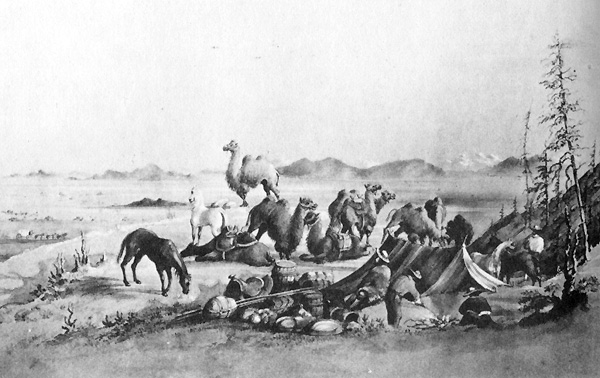Dr. Grumpy re-tells the fascinating story of the importation of camels to North America for use as beasts of burden. He begins:
Following the Mexican-American war, the United States found itself in control of a large desert, covering what’s now New Mexico & Arizona, and parts of Texas, California, and several other states. The U.S. Army needed to establish bases and supply lines in the area, both for the border with Mexico and the continuing wars with Indian tribes.
The railroad system was in it’s infancy, and there were no tracks through the area… The only way across was to use horses. But horses, like humans, are heavily dependent on water. This made the area difficult to cross, and vulnerable to attacking Apaches.
And so in 1855 Jefferson Davis, then U.S. Secretary of War (later to become President of the Confederacy during the Civil War), put into action an idea proposed by several officers: buy camels to serve in the desert. Congress appropriated $30,000 for the endeavor, and officials were sent to Turkey to do just that.
The next year they imported somewhere between 62 and 73 camels and, with them, 8 camel drivers all led by a man named Hadji Ali. Enter the U.S. Army Camel Corps.
Camels at an Army Fort:
 (source)
(source)
Illustration of camels in camp:
 (source)
(source)
Camels on the go (1850s):
 (source)
(source)
Says Dr. Grumpy:
They led supply trains all over, from Texas to California…
But there were problems. The Americans had envisioned combined forces of camels and horses, each making up for the deficiencies of the other. But horses and donkeys are frightened of camels, making joint convoys difficult and requiring separate corrals. The army was also unprepared for their intrinsically difficult personalities- camels bite, spit, kick, and are short-tempered. Horses are comparatively easy to handle.
Then came the start of the American Civil War, which focused military attention to the east. With troops pulled out of the American desert, and horses better suited to the eastern terrain, the camels were abandoned. Though Weird CA suggests that they were used in the war, Dr. Grumpy reports that most simply escaped into the desert. For a time, there was a wild camel population in the U.S.
Meanwhile, a former-solider and Canadian gold prospector, Frank Laumeister, figured that camels would be great pack animals for his new line of work. He bought a herd in 1862, but they didn’t work out so well in the rockier terrain. Plus:
The Canadians, like the Americans, discovered they weren’t easy to handle. The same problems of difficult disposition and spooking horses came up. In addition, they found camels would eat anything they found. Hats. Shoes. Clothes that were out drying. Even soap. And so, after a few years, the Canadians gave up on the experiment, too.
Laumeister on one of his camels:
Our original head camel driver, Hadji Ali, eventually got out of the camel business, but he never left America. He became a citizen in 1880, married a woman named Gertrudis Serna and had two children. He died in Arizona in 1902, having spent 51 years of his life in the U.S. You’ll find his tombstone in Quartzsite, Arizona labeled with the name “Hi Jolly,” the Americanized pronunciation of his full name.
(source)
The last sighting of a wild camel in North America was in 1941 near Douglas, Texas (source).
Lisa Wade, PhD is an Associate Professor at Tulane University. She is the author of American Hookup, a book about college sexual culture; a textbook about gender; and a forthcoming introductory text: Terrible Magnificent Sociology. You can follow her on Twitter and Instagram.

Comments 11
Marcos — January 3, 2011
Hadji Ali appears in Lucky Luke comics! There's a story called "The camel's mine", in which he tries to convince gold miners that camels may be useful.
"The camel's mine" is one of the seven stories in the album "The rope of the hanged" ("La corde du pendu", 1981), written by Morris.
Matthew Glidden — January 3, 2011
Must be why some Southwest states have 19th century laws against the shooting of camels.
Jihad Punk XXX — January 3, 2011
This post was really interesting. I dont like how Hadji Ali's name is Americanized on the plaque. God forbid there be a plague erected for a man with an Islamic sounding name!! (sarcastic)
modchen — January 3, 2011
i think dr. grumpy means "the last *sighting*," so that probably needs a [sic].
leaving behind his numerous other glaring errors, which are plainly enough his own in citation, the last one isn't immediately evident as citation. i'd notate it just to avoid sounding ignorant.
Krishji — January 3, 2011
I am baffled by what appears to be a mixing of both dromedary (one-hump) camels and bactrian (two-hump) camels in these images. What the what?
Cactus Wren — January 6, 2011
And "Hi Jolly" is still a common sobriquet for places in the Southwest: I live about six miles by road from the Hi Jolly Gift Shop:
http://maps.google.com/?ie=UTF8&ll=33.415592,-111.732094&spn=0.004308,0.009645&t=h&z=17&layer=c&cbll=33.415589,-111.732319&panoid=iA4gg2Sg3hz8ZXiKm57O7g&cbp=12,331.23,,0,-1.01
Hypoxia in preeclampsia and the kidney « A world of my own — October 17, 2012
[...] rate, camels are fascinating creatures. The fun historical read of the day is this article from the Society Pages, that shows pictures from a time when Jefferson Davis (yes, that Davis) had a scheme to create a [...]
Another way Texas and Australia are oddly similar: Camels | The Scoop Blog — June 17, 2013
[...] loose to fend for themselves in Texas after interest in the project waned. By some accounts, the last sighting of a feral camel in the United States was in 1941, just east of [...]
B. Alvn — November 10, 2017
By some accounts there are still sightings these days in several western states..